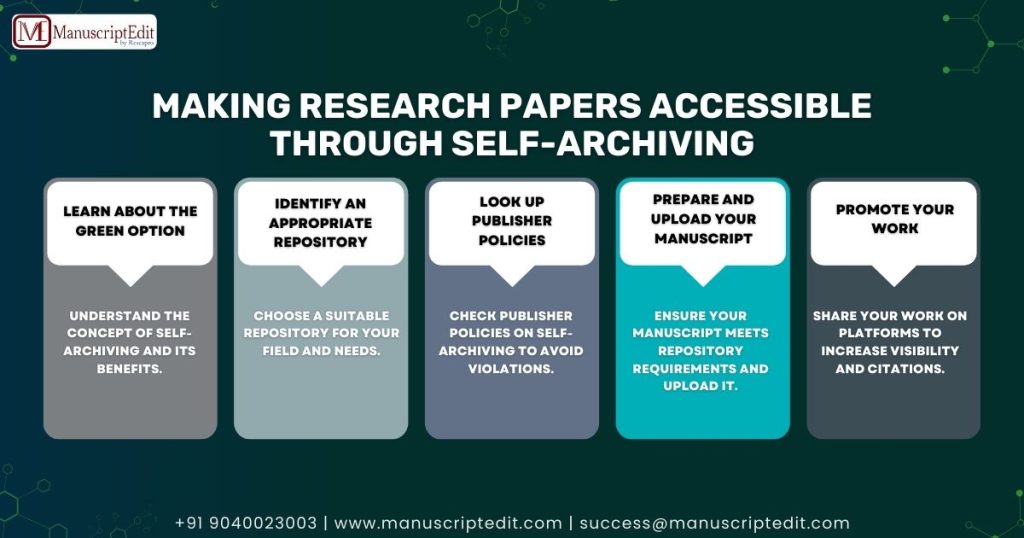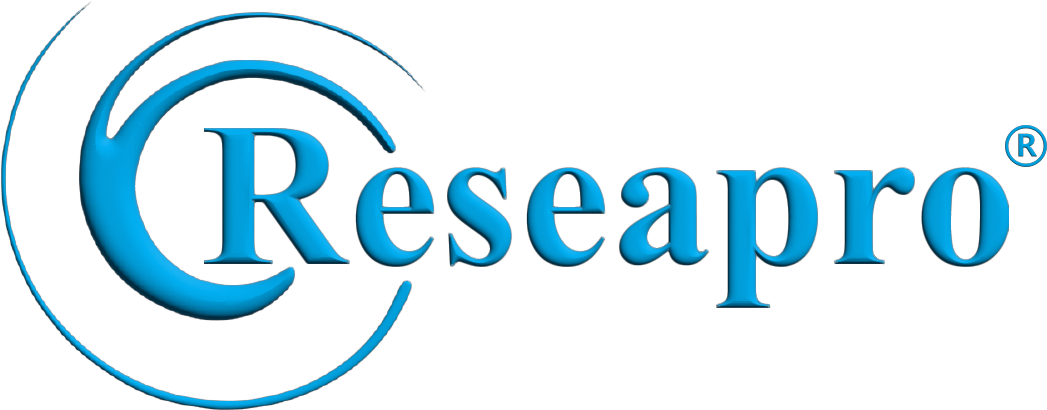
Most research papers are kept behind paywalls, making it hard for the public to read them. In fact, about 85% of these papers are not freely available. An organization called SPARC wants to change this by encouraging open-access publishing. One important way to do this is through self-archiving, also known as “green open access.” It’s simple and affordable: researchers can upload their work online for anyone to see. By self-archiving, scholars—no matter where they live— researchers can share their findings with the world, helping others learn and build on their ideas.
What is self-archiving in research?
Self-archiving is transforming academic publishing, creating a world where equity, accessibility, and visibility thrive! By understanding this process and using helpful tools and repositories, researchers can boost the impact of their work, all while overcoming the difficulties posed by traditional publishing models. Plus, the strong data supporting self-archiving showcases its importance as a key strategy for enhancing global collaboration and speeding up scientific progress.
In today’s collaborative environment, the idea of self-archiving has truly come to light. However, many researchers might not yet realize its remarkable potential or the simple steps they can take to implement it. This blog dives into the essential aspects of self-archiving—covering data, processes, and practical tips—to help research scholars use this powerful tool and navigate their challenges with confidence.
Research Publication Challenges
Lack of Accessibility and Costly
Research availability shows a significant gap that’s worth addressing. Did you know that just 28% of articles in major fields are accessible worldwide? With annual subscription fees for journals exceeding $10,000, many institutions and individuals find it challenging to manage these costs.
This lack of accessibility can really impact academic progress and limit exciting opportunities for interdisciplinary research and public engagement. Studies in fields like medicine and environmental science are so important to society, yet often, they sit behind paywalls, making it difficult for policymakers and practitioners to access this valuable information.
Repository Selection and Compliance.
The institutional and subject-specific maze of repositories is confusing. A study indicates that 35% of the researchers do not know what the requirements of their field are about the repository. Failure to comply with the mandates of the funder, which includes Plan S, leads to penalty or fewer funding opportunities. Additionally, there are different types of repositories, each of which has its specific instruction on file formats, metadata, and embargo periods.
Fear of Copyright Infringement
According to a Wiley survey, 48% of researchers are hesitant to self-archive, mainly because of uncertainty about copyright policies. This often leads to missed opportunities for distribution. Many scholars are not aware that publishers often allow self-archiving of some versions of their manuscripts. Such uncertainties can discourage researchers from taking the green open-access route without proper guidance.
Did You Know?
• 62% of repositories allow Creative Commons licenses, so researchers can control how their work is shared.
• Articles available through green open access are downloaded 89% more than those behind paywalls.
• Self-archiving supports academic transparency and fosters trust in research findings.
How to Make Your Paper More Accessible Through Self-Archiving?
1. Learn About the Green Option
Self-archiving enables authors to make a version of their manuscript available in a repository. This could be the preprint, shared prior to peer review, or the postprint, the final version of the manuscript with all publisher formatting removed. The important work of the research, therefore, is left open to anyone with internet access, even if the published article is behind a paywall.
Statistical Discovery: More than 5,000 repositories worldwide are self-archiving-enabled. Millions of research outputs are accessed because of these repositories through the Directory of Open Access Repositories (OpenDOAR), thereby enhancing access to scholarly work worldwide.
2. Identify an Appropriate Repository
Repositories may be institutional, such as a university archive, or subject-specific, such as arXiv for physics. Choose one relevant to your field and one that aligns with funder requirements. Life sciences researchers might prefer PubMed Central, whereas social sciences researchers would probably make use of SocArXiv.
3. Look up Publisher Policies
Resources such as SHERPA/RoMEO allow researchers to find clear information about publishers’ self-archiving policies. According to statistics, an impressive 81% of publishers allow some form of self-archiving. It is also useful to know what versions are allowed-preprint, postprint, or both-to avoid copyright violations. Moreover, researchers should check any applicable embargo periods before making their work publicly available.
4. Prepare and upload your manuscript
• File Format: Ensure that your manuscript meets the requirements of the repository (PDF/A format). Files which meet standardized formatting guidelines will be more easily accessible and discoverable.
• Metadata: For maximum discoverability, provide full metadata, including keywords such as “self-archiving” and “green option. ” Metadata usually comprises the title, authors, abstract, keywords, and affiliations.
• Embargo Periods: Some publishers have an embargo period before allowing public access. If necessary, make sure to set the right release date.
5. Promote Your Work
Share links to your repository on academic social networks like ResearchGate or ORCID. Prospective researchers who are also advertising their archived work have 23% more citations, says PLOS. Lastly, sharing the links of your archived work in your personal websites, LinkedIn, and other conference presentations will broaden your reach further.

Advantages of Self-Archiving
More Visibility and Citing: A University of Southampton study found that papers self-archived are cited 2.5 times more than those that are not archived. Self-archiving makes research available to more people, thus fostering cross-disciplinary collaboration and maximizing the impact of scholarly work. Compliance with Open Access Mandates
Many funding agencies, including NIH and European Research Council, require open-access publication. Self-archiving enables authors to comply with these mandates without the additional cost of publication fees. Loss of funding or elimination from future grant opportunities would be the result of noncompliance.
Cost-Effective
Although gold open access is often linked with article processing charges that average around $2,000–4,000, self-archiving is free. It is, therefore, very attractive to the researcher, especially those from underfunded institutions or developing countries.
Public Outreach
Open-access research can be accessed by academicians, practitioners, policymakers, and even the general public. For instance, the free availability of environmental studies regarding climate change or public health research about pandemics has a direct impact on society.
Addressing the Misconceptions
Misconception 1: “Self-Archiving Violates Copyright Laws”
Reality: Most publishers allow self-archiving of preprints or postprints provided that the final published version is not used. SHERPA/RoMEO tools make it easy to check policies. Authors should look at what the actual terms of their publisher agreements say.
Misconception 2: “Repositories Lack Credibility”
Fact: Trusted repositories are found in databases such as Google Scholar and PubMed, which helps them reach people all over the world. In addition, these repositories normally undergo strict checks to keep their trustworthiness.
Misconception 3: “Self-Archiving Reduces Publisher Revenue”
Fact: Research has proven that self-archiving helps instead of hurting traditional publishing. Researchers who self-archive normally decide to publish in well-respected journals, which keeps these publishers’ reputations and income strong.
Success Stories
Case Study 1: Improved Accessibility
A PhD candidate at the University of Cambridge self-archived her preprints in arXiv. Six months later, her work was downloaded more than 2,000 times and cited in three high-impact journals. This increased visibility also led to invitations for collaborative projects and conference presentations.
Case Study 2: Easy Compliance
A research group funded by the European Commission used Zenodo to save their work online. This helped them to follow the Horizon Europe rules on open access and reach a larger audience across the world. In addition, saving their work online led to an 18% increase in citation rates within the first year.
Quick Tips for Researchers
• Use tools like SHERPA/RoMEO to check self-archiving policies.
• Follow funder rules by picking the right repository.
• Encourage citations of your deposited content for enhanced visibility
• Regularly update repository profiles with the latest research output.
Ready to take control of your research dissemination? Explore self-archiving and unlock new opportunities for global collaboration.
Manuscriptedit: Your Self-Archiving Partner, Manuscriptedit, supports researchers in self-archiving. Here’s how we can help:
Repository Selection: Find the best platform for your research area.
Copyright Compliance: Get expert help on publisher rules and waiting times.
Metadata Optimization: Improve the visibility of your paper with suggested keywords.
Formatting Assistance: Make sure your manuscript fits the specific needs of the repository.
Frequently Asked Questions
1. Which website do I go to check publisher copyright and self-archiving policies?
Sherpa/Romeo is a good site to search for publisher copyright rules and permissions for self-archiving.
2. Where are the top destinations for self-archiving in my field, and how can I ensure that my paper complies with their submission requirements?
This will depend on your discipline. For instance, arXiv is for physics, mathematics, and computer science, and PubMed Central is for biomedical and life sciences.
– Social Science Research Network (SSRN): This is about social sciences. Manuscriptedit will assist you in preparing your manuscript to meet the specific needs of the repository.
3. Can Manuscriptedit help me improve my paper’s metadata and keywords so more people can find it when I self-archive?
– Yes! Manuscriptedit gives expert tips on creating good metadata and choosing important keywords to make your paper easier to find.
Ready to maximize the impact of your research? Start your self-archiving journey today by choosing a repository and making your work accessible to the world.



